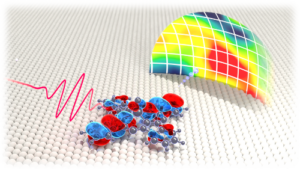Directly watching in slow-motion videos how electrons move in quantum mechanical orbitals and how this motion shapes the functionalities of condensed matter has been a dream shared by all natural and life sciences. Yet, this vision comes with the daunting challenge of mapping the microscopic structure of electronic orbitals with simultaneous ultrafast time resolution.
 We will turn orbital cinematography into reality. This seminal breakthrough will rely on the unique synergies between photoemission orbital tomography (POT), ultrafast photoelectron spectroscopy, lightwave electronics and advanced theory, developed and pioneered by us. Secured by our recent proof-of-principle studies, we will combine these aspects to transform POT to a cinematography at unprecedented time scales, faster than a single oscillation period of light. This will allow us to systematically explore the nanocosmos on its intrinsic femto- to attosecond (the billionth part of a billionth of a second) scales. We will take actual slow-motion movies of molecular orbitals during charge transfer processes, surface chemical reactions, and wave packet motion driven by lightwaves.
We will turn orbital cinematography into reality. This seminal breakthrough will rely on the unique synergies between photoemission orbital tomography (POT), ultrafast photoelectron spectroscopy, lightwave electronics and advanced theory, developed and pioneered by us. Secured by our recent proof-of-principle studies, we will combine these aspects to transform POT to a cinematography at unprecedented time scales, faster than a single oscillation period of light. This will allow us to systematically explore the nanocosmos on its intrinsic femto- to attosecond (the billionth part of a billionth of a second) scales. We will take actual slow-motion movies of molecular orbitals during charge transfer processes, surface chemical reactions, and wave packet motion driven by lightwaves.
Orbital Cinema will thus resolve key questions related to a wide range of applications, from next-generation optoelectronics, energy conversion, photochemistry and catalysis to prospective electronics at optical clock rates. We expect it to revolutionize our understanding of the nanocosmos by elucidating – on elementary spatio-temporal scales – the inner structure of quantum leaps, strong-field control of electrons, charge transfer processes, and chemical reactions as well as their control by electric fields and light.
Since the dawn of quantum mechanics, the temporal evolution of electronic orbitals has been among the most sought-after, yet elusive quantum processes. Our model-free observation of orbital motion establishes an unprecedented ultrafast wave function lab that will carry us to the very foundations of quantum science.






